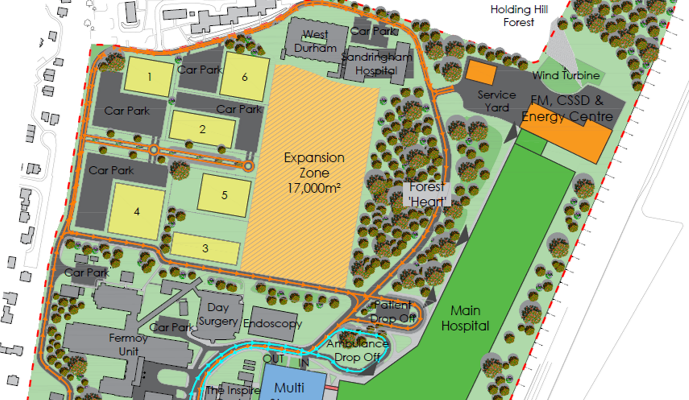Summary
Framework/Partnership // Strategic Partnership
Project Type // Strategic
exi were first appointed by QEH in the summer of 2020 with the objective of developing a compelling case to attract significant funding via the HIP2 capital funding Programme, as known at the time. At the end of September 2020, and following extensive engagement with NHSEI colleagues, the Trust submitted these outputs via a HIP bid for a new hospital as part of the NHS’s response to the Comprehensive Spending Review. Disappointingly, QEH was not on the list of 40 hospitals included in the £3.7billion building package announced in the government’s autumn review in October 2020, however, the strength of QEH ‘case for change’ was acknowledge by national colleagues and seed funding was made available to develop a Strategic Outline Case to support further funding efforts.
The New Hospital Programme was launched, and announcement was made to suggest there will be funding to build a further 8 new hospitals by 2030. exi supported the Trust with a full multi-disciplinary suite of strategic and technical advisory services to successfully submit two Expressions of Interest on 9 September 2021 (with support and advice of regional and national teams); one for a full new hospital on-site and a second for a multi-phase redevelopment on-site.
In the meantime, and in readiness for the further stage of bidding process, exi supported the trust with the delivery of their Strategic Outline Case and supporting Estates Annex. This SOC and long-term estate strategy was completed in Q1 2022 and successfully achieved Trust Board approval in March 2022.

Services
To support the development of the SOC, the exi team provided a team of multi-disciplinary services, covering the following:
Strategic and Technical advisory, Programme and Project Management, Healthcare planning, Digital Advisory, Business Case Authorship and production, Estates Annex advisory including Architectural, Building Services, Net Zero advisory and Cost Consultancy services.
Outputs
The key components developed throughout the delivery of this SOC were:
01
A Pre-SOC paper: To set out a clear plan for delivery we developed a comprehensive plan which at high level, considered the Strategic and Management cases for the SOC and our position with respect to Financial, Commercial and Economic factors. Initial financial and affordability analysis has been reviewed for the key options and goes some way to identifying financial benefits, sensitivities analysis and captures early thinking against economic benefits, which will be developed through the subsequent stages of the Business Case development. This plan was discussed with NHSE colleagues and the Trust Board to provide assurance in the approach to delivery of the SOC.
02
The Operational Brief. Following Clinical engagement, a Model of Care was in line with the Trust’s emerging/draft Clinical Strategy, as shared at the September 2021 Board of Directors’ meeting. This Model of Care output underpins the Operational Brief required to inform the NHP programme. Activity Demand and Capacity modelling was undertaken, incorporating growth, and agreed High Level Planning Assumptions. A Functional Brief has been established in the form of a Schedule of Accommodation. This Functional brief identifies a total demand of 91,280m2 of accommodation for the New Hospital Development Programme.
03
The Business case appraisal process – a weekly workstream meeting was led by exi to ensure all technical aspects of the emerging estates annex were considered and coordinated, and effective communication fed back to other workstreams, and governance up to Trust Board.
a. A range of longlist configuration options were developed and through extensive engagement, where whittled down using HMT Greenbrook guidance to a shortlist of 4 Options which were then developed further.
i. Business As Usual
ii. Single-phase, on-site option
iii. Single-phase, off-site option
iv. Multi-phase, on-site option
b. A formal appraisal was then held to review evidence against the agreed Critical Success Factors, where a ‘Preferred Way Forward’ was identified as the Single-Phase on-site option.
04
The Estates Annex – Once the ‘Preferred Way Forward’ was identified, this option was then developed to a further level of detail and technical aspects considered and documented in a robust Estates Annex report, in support of the business case. A formal Preapplication enquiry was sought from the Local Authority for the proposed scheme and support was provided to give sufficient assurances at this strategic stage. The estates annex covers all technical aspects associated with the new hospital, covering considerations such as Architectural strategy, Engineering Strategy, Timeline and Critical path analysis, Capital costs, Digitally Enabled Care, Net Zero Carbon, Modern Methods of Construction, Government soft landings etc; in line with modern construction practices, government agendas and guidance.

05
10year+ estate strategy – as part of the final SOC Estates Annex outputs, it was important that we set the strategic context and developed a 10-year estate strategy to underpin the case. This estate strategy was approved at Trust Board and sets the context to which the NHP will respond.
06
The Business Case – the exi team authored the Strategic, Commercial and Management cases within the five-case model. With input from colleagues on the Financial, economic cases, exi owned and managed the completion of the business case authorship and led a significant process to coordinate inputs from a range of stakeholders across the organisation; through to completion of the SOC business case document.
07
Expression of Interest for Enabling works – The NHP and DOHSC reached out to those Trusts who were bidding to become one of the additional 8 hospitals on the NHP List to provide a detailed breakdown of what enabling works were required and to provide substantiation in terms of rationale, capital costs, programme, interdependencies, and critical path analysis. The exi team developed the SOC estates annex with a detailed review of these items, which highlighted the need for early investment to accommodate Gas diversion and relocation works, the MSCP (2 Phases), Helipad relocation, seed funding for the development of OBC/FBC, Wind turbine, and various other enabling works to enable main construction works in 2025. This output went through and stood up to heavy scrutiny from regional NHSE colleagues before approval was sought from the Trust Board and submission made in Summer 2022.

